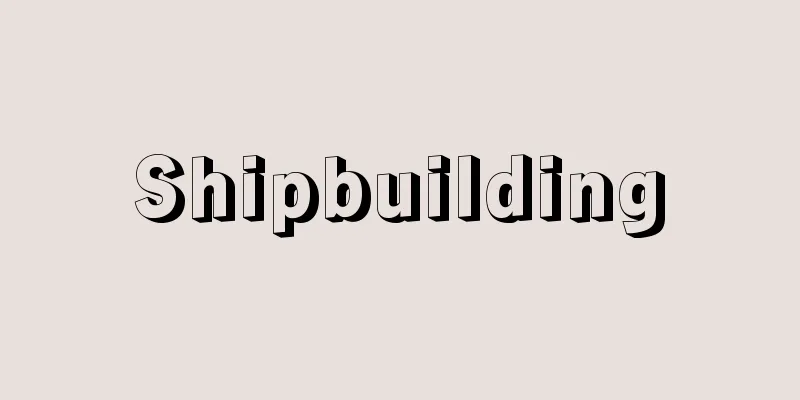Shipbuilding

|
This refers to the work of building a ship, starting from the outline design to the completion of outfitting. A ship is a facility where many passengers and crew members live for long periods of time, like a house or a hotel. It is also equipped with a power plant like a factory in order to transport large amounts of cargo and crew. It is a comprehensive system that can be called a "floating town," combining the functions of a hotel and a factory in a limited space. Moreover, it requires safety and performance to withstand the fierce forces of nature at sea, so each process, including design, construction, launching, and trial operation, requires careful planning and excellent technology. Ships are made to order, with specifications that vary for each ship depending on the route, port conditions, and type of cargo. It takes about one year from order to completion, with some ships taking two or three years. [Morita Tomoharu] Shipbuilding HistoryThe era of wooden shipsHumans have been using boats since around 5000 BC. Ancient boats included rafts, dugout canoes, and leather boats, made from materials readily available in each region. Raft-like reed boats made by bundling together papyrus that grows on the Nile River in Egypt are depicted in ancient murals and are still in use today. Leather boats, made of animal skins stretched over frames such as tree branches, can still be seen upstream the Yangtze River. Once it became possible to process natural wood into planks, larger boats began to be made by joining planks together. The planks were joined together by sewing with vines or string, or by fastening with nails or wooden plugs. A relic, a wooden boat approximately 10 meters long made from several planks, has been excavated from an Egyptian royal tomb dating to around 3000 BC. After that, the era of wooden ships continued for several thousand years until the mid-19th century, passing through Phoenician trading ships, Greek and Roman military ships, Viking ships, and ships from the Age of Discovery. Wooden ships are structurally weak because they do not use metal apart from nails for joining them, and even the ocean-going ships of the Age of Discovery were only a few hundred gross tons in size. In the 19th century, when iron began to be used locally for joints between the deck and outer plating, wooden ships of 2,000 to 3,000 gross tons began to be built. The largest wooden ship in the world is said to be the Adriatic, a 4,145 gross tons ship built in the United States in 1857. [Morita Tomoharu] The transition period to steel shipsAt the end of the 18th century, when iron and iron plates became available in large quantities at low cost, iron ships began to be built. With the advent of steam engines and the demand for larger ships, wooden ships could no longer meet the demand. However, their popularity was slow due to drawbacks such as iron distorting magnetic compasses and shells and seaweed sticking to the bottom of the ship, reducing speed. After the discovery of a magnetic correction method in the 1830s, which prevents the influence of iron by placing several magnets near the compass, many iron ships began to be built. The Great Eastern, built in the UK in 1858, was a huge ship with a length of 207 meters and a gross tonnage of 18,914, but it was so large that it had many problems from the beginning of construction, such as the hull stopping during launching, and it did not perform well in operation. It can be said that it was too large for the level of shipbuilding technology at the time, when other iron ships were only around 5,000 tons. The slowdown in speed caused by shellfish and seaweed adhering to the bottom of the ship was a major obstacle on routes to the East, where the frequency of cleaning at the dock could not be increased. Therefore, along with iron ships, covered ships and ships made of wood and iron were introduced. Wooden ships were covered with copper or brass plates, which are toxic to organisms that attach below the waterline. However, in the case of iron ships, the iron and these metal plates create a galvanic reaction in the sea, causing the iron to corrode rapidly. For this reason, ships were built as warships, with wood as an insulator on top of the iron, and then copper or brass clad on top of that. Additionally, wood-and-iron ships, which used iron for the main structural members such as ribs, beams, pillars, and longerons, were used as clippers and merchant ships on the Oriental routes. Around 1890, iron ships rapidly gave way to steel ships, but they still formed the prototype of modern ships in terms of structure. Decks made of beams, reinforcement of the outer plate with ribs, and double bottoms were methods used on iron ships. The double structure and longitudinal structure of the ship's sides were developed into the structures of container ships and the large ships built after 1960, respectively. The construction method of riveting the keel and bottom plate gradually upwards on a platform was also inherited by steel ships, and continued until around 1950. [Morita Tomoharu] Steel ships and high-tensile steel shipsAdvances in steelmaking methods led to the construction of steel ships in the mid-19th century. Steel could achieve the same strength as iron with 80% of the amount of iron. Furthermore, from the beginning of the 20th century, warships and giant ships began to use high-tensile steel, which has 50% greater tensile strength than mild steel, for part of their hulls. Advances in hull materials contributed greatly to the competition between the luxury mammoth passenger liners that were deployed mainly on Atlantic routes. However, shipbuilding techniques and methods did not fundamentally change from the era of iron ships until after World War II. [Morita Tomoharu] Post-World War II ChangesThe development of shipbuilding technology after World War II was remarkable. New ships were built one after another to maximize their capabilities according to their purpose, such as gigantic tankers exceeding 500,000 deadweight tons, container ships with speeds comparable to prewar luxury cruise ships, car carriers, and liquefied gas carriers. The main technological innovations that made this possible were electric welding of steel and the block construction method. Electric welding had been used partially before World War II, but was unreliable and hardly put to practical use in Japan. The United States adopted it during the war, building about 5,000 wartime standard ships, but of these, about 1,000 suffered structural accidents, such as large breaks in the deck or bottom. After World War II, many countries began building welded ships to shorten construction times and reduce weight, but accidents continued. With riveted joints, cracks rarely spread to adjacent plates, but with welding, steel plates are joined together as if they were one piece, so cracks caused by small scratches during welding or structural defects spread one after another, causing brittle fracture. After that, improvements were made to welding methods, steel materials, and welding rods in various countries, and the problem of brittle fracture was solved by the early 1950s. With the reliability of electric welding established, around 1960, the block construction method was developed, in which the hull is assembled in several blocks, then transported to a slipway and welded to complete the hull. In the previous construction method, the keel was placed on the slipway, and the bottom shell plates were joined to the left and right sides of the keel, while the ribs were attached to the inside. The upper ends of the ribs extended upward on both sides were connected with beams, and the shell plates and deck were laid on this framework. This was a low-productivity construction method that required a lot of labor and time, including manual work in a narrow and high space, management of assembly procedures, and transportation of many types of materials. With the block construction method, each block is welded on an assembly table with good footing, which improves both efficiency and precision. Specialized equipment such as cranes and trailers can be used efficiently to transport the blocks. Automatic welding machines can be used in many areas to join the blocks on the slipway. Although similar to the prefabricated construction method used for houses, in shipbuilding it had even greater benefits than construction, and in one fell swoop the inefficiencies of the riveting era construction methods were overcome. [Morita Tomoharu] Shipbuilding ProcessInquiries and ContractsA quote is when a shipowner specifies the deadweight, number of passengers, speed and other conditions of the ship to be built and asks a shipyard for a rough design and price estimate. The first step in design is to estimate the main dimensions, i.e. the approximate values of the ship's length, width and depth. Usually, an existing ship that is close to the shipowner's requirements is used as a reference. Next, the horsepower of the main engine that can ensure the required speed and the basic elements of the hull form are determined. Taking into consideration other requirements of the shipowner and performance such as strength and stability, the most economical main dimensions are selected. The design process is a continuous process of trial and error, and if there is even one item that is not satisfactory, the accuracy of the design is improved by repeatedly revising the main dimensions, horsepower of the main engine, etc. In parallel with this, three basic drawings are created. There are three types of drawings: a "general arrangement drawing" showing the layout of cargo holds, living quarters, engine room, and various equipment in side views and deck plans; a "line drawing" showing the exterior shape of the ship in multiple cross sections, longitudinal sections, and horizontal sections; and a "structural drawing" consisting of a central cross section showing the thickness and size of the outer plate, deck, ribs, and beams, as well as a steel arrangement drawing in the same three cross sections. During the design process, frequent discussions are held with the shipowner, and if an agreement is reached on performance, ship price, delivery date, etc., a specification document is prepared and a contract is made. Depending on the shipowner, some may outsource the above steps to a design company or perform them in-house, and then a contract shipyard is selected through a bidding process. There are various types of work, from estimating the main dimensions and main engine horsepower to calculate a very rough ship price, to completing three types of basic drawings, which are called estimate design and preliminary design. [Morita Tomoharu] Design DeploymentIn the initial design, only the minimum consideration is made to calculate the ship price, so detailed calculations and comparison with data from actual ships are made. This is the start of work up to the creation of construction drawings. If the line drawings have not been finalized, large drawings are made and the details are considered. For new ship types, tank tests using models may be necessary. In addition, many basic drawings are created, such as shell development drawings, loading and unloading equipment drawings, rudder structure drawings, engine room overall layout drawings, shafting and propeller drawings, piping system drawings, and electrical system drawings, and freeboard calculations, gross tonnage calculations, horsepower calculations, and power calculations are also prepared. Based on this, construction drawings are written that instruct the assembly method of the ribs, beams, and plates of each part of the hull, and the installation method of the main engine, generator, reduction gear, etc. In addition, after considering what blocks the hull should be divided into and in what order to transport it to the slipway for efficiency, small assembly instructions, large assembly instructions, and slipway installation instructions are prepared. In addition to the design work, another important task is to draw up ordering plans with each manufacturer to ensure that steel materials, main engines, and numerous other machines and equipment are delivered at the appropriate time. [Morita Tomoharu] Steel processingSteel plates and shaped steel are cut into flat shapes that can be assembled three-dimensionally. The shapes are drawn on a drawing and then transferred to the material by marking. Traditionally, a full-scale development drawing was drawn on a large wooden floor, and marking was done manually using a measurement chart, a pattern, and a full-scale wooden model, so it required a high level of skill, a lot of effort, and time to ensure accuracy. In the 1960s, an electrophotographic marking method was developed in which a one-tenth scale drawing was projected onto a steel plate coated with a photosensitive agent and transferred to the image. This was followed by the realization of a numerically controlled (NC) method in which the drawing was digitized and a gas cutting machine was automatically operated. Recently, with the development of computers and robotics technology, the process from line drawing to drawing and NC processing is carried out continuously, and the capacity and accuracy have improved significantly. [Morita Tomoharu] Hull constructionShipbuilding is broadly divided into hull construction, which creates the hull, and outfitting, which installs the main engine and other machinery and equipment. The majority of hull construction involves welding, assembling, and transporting steel materials. The marked and cut steel materials are machined to drill and bend them, and then sent to the sub-assembly area, where they are assembled into shapes and sizes that are easy to handle when assembling blocks. The weight of the finished products at the sub-assembly area ranges from a few tons to around 20 tons. Most of the process involves welding, which is carried out on a fixed surface plate in the factory, and devices and equipment such as overhead traveling cranes are used. Compared to the conventional construction method in which the many parts handled at the sub-assembly area were all transported to a narrow, poorly-footed slipway and assembled there, this method has significantly improved efficiency, precision, and safety. After completing the sub-assembly, the parts are transported by trailer or special transport equipment to the main assembly area, where they are assembled into blocks to be mounted on the slipway. The size of the blocks depends on the type and size of the ship, but they are usually around 100 to 200 tons. The larger the block, the less work on the slipway and the higher the efficiency. If the loading crane is large and the assembly area is large, blocks of about 600 tons can be loaded. The blocks are divided not necessarily according to their use such as cargo holds or engine rooms, but based on the efficiency of the construction process. The assembly process is mostly welding work, and various types of automatic welding are used to increase efficiency, such as automatic welding that can weld thick plates in one go and one-sided automatic welding that does not require welding on the back side. For large ships, hundreds of blocks are loaded on the slipway, and their positioning to finish the hull accurately is done using transits and laser measuring devices. The positioning must also take into account shrinkage and deformation due to welding. In order to keep the propeller shaft and rudder shaft accurately on the center line, it is also necessary to predict the deformation of the hull after launching, which is only possible with the accumulation of know-how unique to each shipyard. [Morita Tomoharu] Outfitting workOnce the hull work is complete and the ship is launched, it is moored at the outfitting quay. Outfitting work is broadly divided into hull outfitting, engine outfitting, and electrical outfitting. Hull outfitting involves the installation of steering gear, navigational instruments, mooring equipment such as anchor windlass, cargo handling equipment, life-saving equipment, ventilation and air conditioning equipment, fire extinguishing equipment, various piping systems, and accommodation facilities, as well as painting and corrosion protection. Engine outfitting involves the installation of the main engine, boiler and other equipment in the engine room, engine-related piping systems, propeller shafts and bearings, and propellers. Electrical outfitting involves the installation of electric wires, switches, and electrical equipment. When building on a slipway, heavy items such as the main engine are installed after launching to reduce the launching weight, but parts that cannot be worked on after launching, such as the rudder, propeller, and propeller shaft, as well as mooring equipment necessary for launching, are installed before launching. Conventionally, most outfitting work was done after the ship was launched, but with block construction, piping, ventilation trunks, electric wiring conductor plates, etc. are incorporated into each block, and bathrooms, kitchens, laundry rooms, etc. are equipped as a single unit in the block and then mounted on the slipway. The block construction method has also made it possible to dramatically shorten the construction period, reduce costs, and improve quality in outfitting work. [Morita Tomoharu] Testing and InspectionShips must pass tests and inspections prescribed by many laws and related regulations, such as the Ship Safety Act, Radio Act, and Maritime Collision Prevention Act. In addition, ships must pass the prescribed tests and inspections to be registered with a classification society. Cars and aircraft only need to pass the type test, but ships must pass it on an individual basis. Before construction begins, various material tests are conducted on steel and other specified materials. At each stage of construction, tests and inspections are conducted at designated times, such as hydrostatic tests when tanks are completed. Important items purchased from each manufacturer are delivered after the shipyard is present to confirm their dimensions and performance. When construction is almost complete, a center of gravity assessment test is conducted to measure the ship's weight and center of gravity. Before sea trials, the ship is moored to the quay and the main engine is operated at very low power. This is to ensure that the main engine, propeller, propeller, etc., which have been individually tested and inspected on land, are in good condition as a series of propulsion devices. Sea trials involve actually sailing on the ocean to check whether performance such as speed is in line with the contract and design. Official test results are recorded in the presence of relevant parties such as the shipowner, supervisory authorities, and classification societies. Speed tests, turning force tests, forward coasting tests, steering tests, and main engine starting tests are conducted, and the operation of nautical instruments such as magnetic compass, gyrocompass, radio equipment, and depth sounders is also checked. Once trials are complete, final finishing work is carried out, and the main engine, boiler, etc. are disassembled and inspected. The ship is handed over to the shipowner approximately 10 days after the trials are completed. [Morita Tomoharu] "The World History of Ships" by Kiichiro Ueno (1980, Kajakusha)" ▽ "The Fundamentals of Merchant Ship Design" revised edition by the Shipbuilding Textbook Study Group (1982, Seizando Shoten)" ▽ "Shipbuilding Engineering" edited by the National Shipbuilding Education Research Group (1975, Kaibundo Publishing)" ▽ "Knowledge of Ships" by Kiichiro Ueno (1962, Kaibundo Publishing) [Reference] | | | | | |©Shogakukan "> Large ship building process Source: Shogakukan Encyclopedia Nipponica About Encyclopedia Nipponica Information | Legend |
|
船をつくる作業のことで、概略設計に始まり艤装(ぎそう)の完了までをいう。船は、住宅やホテルのように、多数の乗客や乗組員が長い間生活する施設である。また大量の貨物や乗員を運ぶために、工場のような動力装置を備えている。限られたスペースの中にホテルと工場の二つの機能を共存させている「浮かぶ町」ともいうべき総合的なシステムである。しかも海上での自然の猛威に対抗する安全性と性能が要求され、設計、工作、進水、試運転などの各工程に綿密な計画と優れた技術が必要である。船は、航路や港湾の事情、積み荷の種類などに応じて、一隻ごとに仕様が違う一品ずつの注文生産である。注文から完成までに約1年間から、船によっては2、3年間が必要である。 [森田知治] 造船の歴史木造船の時代人類は紀元前5000年ごろから船を使っていた。太古の船は筏(いかだ)、丸木舟、皮舟などで、地域ごとに利用しやすい材料でつくられた。エジプトのナイル川に茂るパピルスを束ねて組み合わせた筏状の葦(あし)舟は古代の壁画にも描かれ、現在でも使われている。木の枝などの枠に動物の皮を張った皮舟も、いまなお揚子江(ようすこう)上流にみられる。天然の木を板に加工できるようになると、板を継ぎ合わせてより大きい船をつくるようになった。接合は植物のつるや紐(ひも)での縫合か、釘(くぎ)や木栓での固着が用いられた。遺物として、前3000年ごろのエジプトの王墓から、数枚の板材で組み合わせられた長さ約10メートルの木船が発掘されている。 その後、フェニキアの交易船、ギリシアやローマの軍船、バイキングの船、大航海時代の船などを経て、19世紀中ごろまで、数千年は木船の時代が続いた。木船は接合のための釘類のほかは金属を使わないので構造的に弱く、大航海時代の航洋船でも数百総トン程度の大きさだった。19世紀になって、鉄材が甲板と外板の接合部などに局部的に使われるようになると、2000総トンから3000総トンの木船がつくられるようになった。世界最大の木船は、1857年にアメリカで建造された4145総トンのアドリアチック号といわれている。 [森田知治] 鋼船までの過渡期18世紀の末に鉄材や鉄板が大量に安く供給されるようになると、鉄船がつくられだした。蒸気機関の出現や大型化の要求に、木船では対応できなくなったのである。しかし、鉄が磁気コンパスを狂わせたり、船底に貝や海藻類が付着して速力を低下させるなどの欠点から、普及が遅れていた。1830年代にコンパスの近くに数個の磁石を置いて鉄の影響を防ぐ磁差修正法が発見されてからは、多くの鉄船が建造されるようになった。1858年イギリスでつくられたグレート・イースタン号は、長さ207メートル、1万8914総トンの巨船だったが、あまりにも大きすぎて進水途中で船体が止まってしまうなど建造当初からトラブルが多く、運航の実績も芳しくなかった。ほかの鉄船が5000トン前後までだった当時の造船技術の水準としては過ぎた大きさだったといえるだろう。 船底に付着する貝や海藻による速力の低下は、ドックで清掃する回数を増やすことのできない東洋方面などの航路には大きな障害だった。そこで鉄船と並んで登場したのが被覆船と木鉄交造船である。 木船では、水線下に付着する生物に対して毒性のある銅板、黄銅板を張ることが行われていた。しかし鉄船では、鉄とこれらの金属板が海中で電池作用をおこして鉄を急速に腐食させる。そこで鉄の上に絶縁体としての木、さらにその上に銅や黄銅を張った被覆船が、多くは軍艦として建造された。また、肋骨(ろっこつ)、梁(はり)材、柱材、縦通材(じゅうつうざい)などの主要な構造材として鉄材を使った木鉄交造船も、クリッパーや東洋航路の商船として使われた。 鉄船は1890年ごろを境に、急激に鋼船に席を譲ったが、構造上現在の船の原型をつくりあげている。梁材による甲板、肋骨による外板の補強、二重船底などは鉄船に用いられた方法である。船側の二重構造や縦式構造は、それぞれコンテナ船や1960年以降の大型船の構造に発展した。また、船台上でキールや船底外板からしだいに上方へリベットで結合してゆく建造法も鋼船に受け継がれて、1950年ごろまで続けられた。 [森田知治] 鋼船と高張力鋼船製鋼法の進歩によって19世紀のなかば過ぎから鋼船の建造が始まった。鋼材は、鉄の八割の量で同じ強度を得ることができた。さらに20世紀の初めからは、軍艦や巨船はその船体の一部に、軟鋼に比べて50%も引張り強さの優れた高張力鋼を使用するようになった。大西洋航路を中心に展開された豪華マンモス客船の競合には、船体材料の進歩が大きく貢献している。しかし、造船の技術や方法は、第二次世界大戦後まで、鉄船時代と根本的な差異がない。 [森田知治] 第二次大戦後の変革第二次大戦後の造船技術の発展は目覚ましい。50万重量トンを超える巨大タンカー、戦前の豪華客船なみの速力のコンテナ船、自動車専用船、液化ガス運搬船など、用途に応じて能力を最大限に発揮する新しい船が相次いで建造されてきた。これを可能にした技術革新の主要なものに、鋼材の電気溶接とブロック建造法がある。 電気溶接は第二次大戦以前から部分的に使われていたが、信頼性が低く日本ではほとんど実用化されなかった。アメリカでは戦時中に採用し、約5000隻の戦時標準船を建造したが、そのうち約1000隻に甲板や船底が大きく破断するなどの構造上の事故が多発した。第二次大戦後、工程の短縮、重量の軽減などのために各国で溶接船がつくられるようになったが、相変わらず事故が続いた。リベット接合では割れが隣の板まで広がることは少ないが、溶接では鋼板どうしが一枚のように結合されているので、溶接時の小さな傷や、構造上の欠陥などで生じた亀裂(きれつ)が次々と波及して脆性(ぜいせい)破壊をおこすのである。その後、各国で溶接法、鋼材、溶接棒の改良が進み、1950年代の初めには脆性破壊の問題は解決された。 電気溶接の信頼性が確立されたことにより、1960年ごろから、船体をいくつかのブロックに分けて組み立てておき、船台に運んで溶接し船体を完成するブロック建造法が開発された。それまでの建造法では、船台上にキールを置き、その左右に船底外板を接合してゆくとともに内側へ肋骨を取り付ける。両舷(りょうげん)で上へ伸ばした肋骨の上端を梁材でつなぎ、その枠組みに外板や甲板を張っていった。狭く高い場所での手作業、組立て手順の管理、多種類の材料の運搬など、多くの労力と時間を要する生産性の低い建造法だった。ブロック建造法では、各ブロックを足場のよい組立定盤(じょうばん)の上で溶接してゆくので、能率も精度も向上する。ブロックの運搬にはクレーン、トレーラーなどの専用器具を効率的に使用できる。船台上のブロック接合には自動溶接機を使える部分が多い。家屋のプレハブ工法に似ているが、造船の場合は建築以上の効果があり、リベット時代の建造法の非能率性は一挙に克服された。 [森田知治] 造船の工程引合と契約船主が、建造しようとする船の載貨重量、旅客数、速力その他の条件を指定して、造船所に概略設計と価格の見積りを依頼するのを引合という。設計の第一歩は主要寸法、つまり船の長さ、幅、深さの概略値の推定である。普通、船主の要求に近い既存の船を参考にする。次に要求速度を確保できる主機関の馬力、および船型の基本要素を定める。そのほかの船主の要求事項や、強度、復原性などの性能を考慮して、もっとも経済的な主要寸法を選び出す。設計作業は試行錯誤の連続で、一つでも満足できない事項があれば、主要寸法、主機関の馬力などの修正を繰り返しながら設計精度をあげてゆく。これと並行して3種類の基本図面を作成する。貨物倉、居住区域、機関室、諸設備などの配置を側面図と各甲板平面図で示した「一般配置図」、船体の外形をそれぞれ多数の横断面・縦断面・水平断面で表した「線図」、同じく3種類の断面に、外板、甲板、肋骨(ろっこつ)、梁(はり)材などの厚さや大きさを示した中央断面図と鋼材配置図からなる「構造図」の3種である。設計過程で頻繁に船主との協議が行われ、性能、船価、納期などの合意が得られれば仕様書が作成されて契約となる。船主によってはこれまでの段階を設計会社に委託したり自社で行って、入札で請負造船所を決めることもある。また作業内容も、ごく大まかな船価を算出するために、主要寸法、主機馬力などを推定する程度から、3種類の基本図面を完成するまでの種々の形態があって、見積り設計、初期設計とよばれる。 [森田知治] 設計の展開初期設計では船価を算定するための最小限度の検討しかされていないので、詳細な計算、実績船のデータとの照合が行われる。工事用図面の作成までの作業の開始である。線図が確定していなければ大きな図面をつくって細部を検討する。新しい船型で、模型による水槽試験が必要な場合もある。さらに、外板展開図、荷役装置図、舵(かじ)構造図、機関室全体配置図、軸系およびプロペラ図、諸管系統図、電路系統図など多くの基本となる図面がつくられ、乾舷(かんげん)計算書、総トン数計算書、馬力計算書、電力計算書なども作成される。これに基づいて船体各部の肋骨、梁材、板材などの組立て法や、主機関、発電機、減速機などの据え付け方を指示する工事用図面が書かれる。また、船体をどのようなブロックに分割し、どんな順序で船台へ運べば効率がよいかの検討を経て、小組立要領図、大組立要領図、船台搭載要領図などを作成する。設計作業とともに、鋼材や主機関をはじめ多数の機器、装置類が適切な時期に確実に納入されるよう各メーカーへの発注計画をたてることも重要な作業である。 [森田知治] 鋼材の加工鋼板や形鋼は立体的に組み立てることのできる平面形状に切断する。その形状を現図に描き、罫書(けがき)作業によって材料に転写する。従来は、広い木製の床に実物大の展開図を描き、寸法表や型紙、木製の実物大模型などを使って、人手による罫書作業が行われていたので、精度を確保するには高い熟練と多くの労力、時間が必要だった。1960年代になって、10分の1に縮尺した現図を、感光剤を塗った鋼板に投影して転写する電子写真罫書法が開発された。続いて、現図を数値化してガス切断機を自動的に動かす数値制御(NC)方式も実現した。最近はコンピュータやロボット技術の発展によって、線図から現図、NC加工の工程が連続的に行われ、能力と精度は著しく向上している。 [森田知治] 船殻工事造船工事は、船体をつくる船殻(せんかく)工事と、主機関ほかの機械や設備を取り付ける艤装(ぎそう)工事とに大別される。船殻工事の大半は鋼材の溶接、組立てと運搬作業である。罫書、切断された鋼材は、機械加工で穴をあけたり曲げたりされて小組立場へ送られ、ブロック組立ての際に取り扱いやすい形と大きさにまで組み立てられる。小組立場でのできあがり重量は数トンから20トンぐらいである。工程の大部分は溶接で、工場内に固定した定盤(じょうばん)の上で行い、天井走行クレーンなどの装置や器具が使われる。小組立場で扱う多くの部材を、すべて狭く足場の悪い船台に運び、組み立てていた従来の建造法に比べて、能率、精度、安全性ともに大幅に向上した。小組立てを終えた部材は、トレーラーや専用の運搬装置で大組立場へ運ばれ、船台に搭載するブロックにまとめられる。ブロックの大きさは船の種類や大きさにもよるが、普通は100トンから200トン程度である。ブロックが大きければ大きいほど船台上での作業が減り能率が向上する。搭載用クレーンが大きく、大組立場が広い場合には600トンぐらいのブロックの搭載も可能である。ブロックの分け方は、かならずしも貨物倉とか機関室などの用途別ではなく、建造工程が効率的であることが基準である。大組立工程も大部分が溶接作業で、厚板を1回で溶接できる自動溶接、裏側を溶接しないでもすむ片面自動溶接など各種の自動溶接が駆使されて能率をあげている。船台上に搭載されるブロックは、大型船では数百個にも上り、正確な船体に仕上げるための位置決めは、トランシットやレーザー計測装置によって精密に行われる。位置決めには溶接による収縮や変形も考慮しなければならない。また、推進軸や舵軸を正確に中心線に保つには、進水後の船体の変形も予測する必要があり、各造船所独特のノウハウの蓄積によって初めて可能になる。 [森田知治] 艤装工事船殻工事が終わって進水した船体は、艤装岸壁に係留される。艤装工事は船体艤装、機関艤装、電気艤装に大別される。船体艤装は、操舵(そうだ)装置、航海計器、揚錨(ようびょう)機などの係船装置、荷役装置、救命設備、通風・空気調整装置、消火装置、諸管装置、居住区設備などを取り付け、塗装と防食を行う工事である。機関艤装は、主機関、ボイラーなど機関室内の機器、機関関係の管系統、推進軸と軸受、プロペラなどの取り付け作業である。電気艤装は電線やスイッチ類、電気機器の取り付け作業である。主機関などの重量物は、船台での建造の場合、進水重量を軽くするために進水後に据え付けられるが、舵、プロペラ、推進軸など進水後には作業できない部分や、進水時に必要な係船装置などは進水前に取り付けられる。従来の艤装工事はほとんどが進水後だったが、ブロック建造の場合には、配管、通風トランク、電線導板などを各ブロックに組み込んだり、浴室、調理室、洗濯室などを一つのユニットとしてブロックに装備して船台に搭載する方法が採用されている。艤装工事もブロック建造方式によって飛躍的に工期の短縮、経費の節減、品質の向上が可能になっている。 [森田知治] 試験・検査船は、船舶安全法、電波法、海上衝突予防法など多くの法律や関連する法令が定める試験・検査に合格する必要がある。また、船級協会に登録するには所定の試験・検査にも合格しなければならない。自動車や航空機は型式として合格すればよいのだが、船は1隻ごとである。着工前にも鋼材ほかの指定された材料について各種の材料試験がある。工事の各過程でも、タンク完成時の水圧試験のように、所定の時期にその工事についての試験や検査が行われる。各メーカーからの購入品の重要なものは、造船所側も立ち会って、寸法、性能の確認のうえ納入される。建造工事がほぼ完了する時期に、船の重量と重心位置を測定する重心査定試験がある。海上試運転の前には、船を岸壁に係留したまま主機関をごく低出力で運転する係留運転が行われる。これは、個々に陸上で試運転や検査を終わっている主機関、推進軸、プロペラなどが一連の推進装置として異状がないことを確認するためである。 海上試運転は、海上を実際に走ってみて、速力などの性能が契約や設計どおりになっているかどうかの試験である。船主、監督官庁、船級協会などの関係者が立ち会って、公式な試験成績が記録される。速力試験、旋回力試験、前進惰力試験、操舵試験、主機始動試験などが行われ、磁気コンパス、ジャイロコンパス、無線機器、測深機などの航海計器類の作動状況も確認される。試運転が終わると最後の仕上げ工事を行い、主機関やボイラーなどを分解、点検する。試運転終了後10日前後で船は船主に引き渡されることになる。 [森田知治] 『上野喜一郎著『船の世界史』(1980・舵社)』▽『造船テキスト研究会著『商船設計の基礎』改訂版(1982・成山堂書店)』▽『全国造船教育研究会編『造船工学』(1975・海文堂出版)』▽『上野喜一郎著『船の知識』(1962・海文堂出版)』 [参照項目] | | | | | |©Shogakukan"> 大型船の造船工程 出典 小学館 日本大百科全書(ニッポニカ)日本大百科全書(ニッポニカ)について 情報 | 凡例 |
Recommend
Cora Sandel
1880‐1974 Norwegian female novelist. Her real name...
Aomuro - Aomuro
...It reaches a total length of 40cm. Its back is...
Peter Lely
1618‐80 A portrait painter of Dutch descent active...
Idetori - Idetori
…The word “boiled food” appears in the “Wamyo-sho...
Kagari Mari
...The late Edo period book Kiyu Shoran states th...
Eiraku Encyclopedia - Eiraku Encyclopedia
The largest encyclopedia ever compiled in China. ...
Carolina allspice
It is a deciduous shrub of the family Celastrusace...
Kirimine Shrine
…Because it borders Iwakuni City and Yanai City, ...
Ichijokyo
…Shravakas are the least capable, and are guided ...
Hieracium aurantiacum (English name)
… [Morita Tatsuyoshi]. … *Some of the terms that ...
Lunts, L. (English spelling) LuntsL
…From this time on, under the influence of Tynyan...
Quercus glauca (English spelling)
…[Motoji Okamoto] [Aya Nitta]. … *Some of the ter...
Pearl Island
A small island in Toba Port, belonging to Toba Ci...
Geoffroy, E.F. (English spelling) GeoffroyEF
...Generally, it is a general term for the possib...
QB - Cube
《 quarterback 》 In American football, the quarterb...









